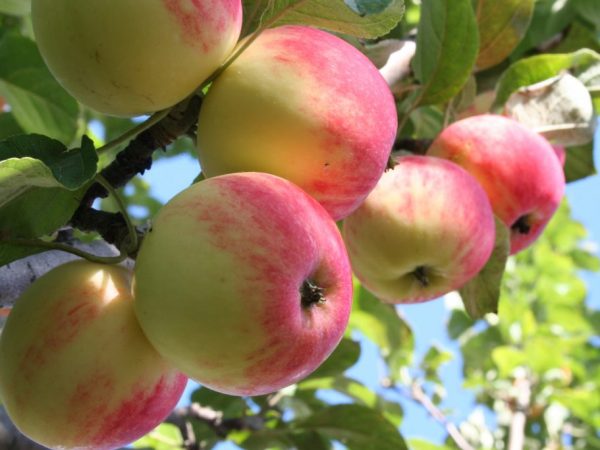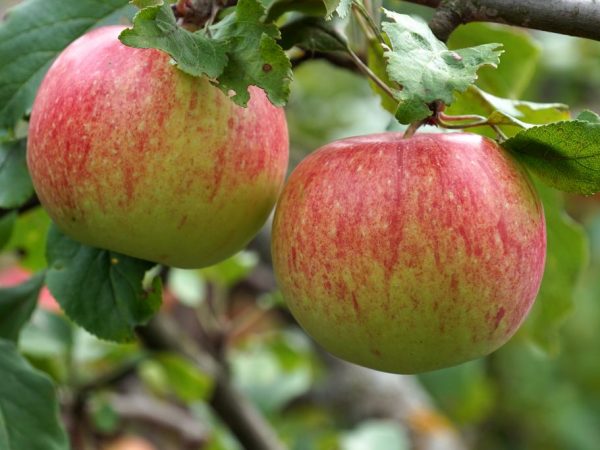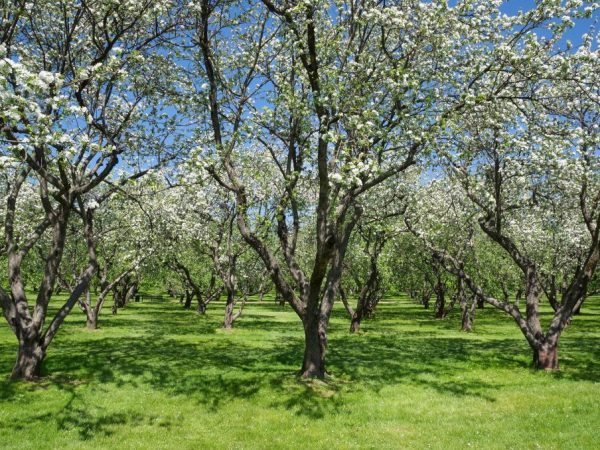Varietal characteristics of the Mantet apple tree
Apple Mantet is a fairly popular variety among Russian gardeners. It is grown both in summer cottages and in large garden farms. With timely care, it pleases with an abundant harvest of sweet and beautiful fruits. In addition, it has the highest palatability among early-ripening apple trees.

Varietal characteristics of the Mantet apple tree
Characteristics of the variety
The first mentions of the Mantet variety were recorded in 1982 in the city of Morden. Breeders from Canada bred it by natural pollination of the domestic Moscow pear tree. Subsequently, he gained popularity in Russia.
After entering the State Register, it is recommended for cultivation in the Middle Volga and Central regions of the country.
In relation to the progenitor, the species is less frost-resistant, for the winter it requires the shelter of the trunk. It is not recommended to grow it in regions where the temperature drops below 20 ° C in winter.
The best pollinator for him is considered the variety White filling, Melba is also suitable.
Yield
The variety is early maturing. The first harvest, with sufficient warming in winter and observance of favorable conditions for development, occurs in the 3rd year of life. Mantet apples can be harvested in mid-July.
In regions where summers are cold and there are few sunny days, the ripening of the crop can take until mid-August. The fruit does not lose its presentation when stored in a warehouse for about 2 weeks, in a refrigerator - for about a month.
A young tree bears fruit abundantly every year, and with age - after a year. The maximum amount of fruit gives from 15 years old to 50. Productivity with proper cultivation reaches about 150 kg of apples per tree.
Advantages and disadvantages
Like any other horticultural crop, the cultivar has both positive and negative characteristics.
The following criteria can be classified as positive:
- a compact and thin crown allows you to grow a tree in small personal plots and break up beds in row spacing;
- the sweet taste of the fruit provides a fairly economical consumption of sugar when preparing for the winter;
- early fruiting after planting;
- no need for regular pruning;
- resistance to transportation of fruits, despite the delicate skin;
- high productivity.
Among the disadvantages of the Mantet apple variety are:
- short storage period of the crop;
- rapid overripening of apples when untimely removal from the branches;
- susceptibility of the variety to scab during rainy weather;
- reduction in fruit size in case of a bountiful harvest;
- vertical growth of skeletal branches makes chemical treatment and harvest difficult.
Description of the tree
The seedling grows rapidly. The apple tree of this variety belongs to medium-sized trees, its maximum height is 4 m. The skeletal branches are powerful and directed upwards. The crown is formed oval, not too thickened. Cranked shoots with lenticels located on them.
The leaves are large, green. Flowering occurs in the second decade of May. Flowers are pink, delicate, large, with a pleasant delicate aroma. Petals are saucer-shaped, elongated. Shortened pistil.
Fruit characteristics

The fruits are delicious fresh
Ripe apples are greenish-yellow in color. In addition, a pink blush with a speckled and striped pattern is expressed. The skin is smooth and delicate to the touch. The pulp is light creamy, juicy. Fruits are medium in size, weighing no more than 160 g.
The taste is dessert, sweet, pleasant. On the scale, the Mantet apple variety gets 4.6 points. The fruits have a weak, almost imperceptible aroma. The texture of the pulp is homogeneous with a slight acidity. Winter preparations, juices are made from it. The calorie content of an apple is 48 kcal per 100 g. The fruits contain about 10% sugars.
Growing
The variety belongs to trees that cannot tolerate low temperatures, therefore, young trees are planted in early April, during the dormant period, so that they have time to adapt and gain strength for the winter.
The landing site should be protected from the wind, have loose soil and a low water table. If it is higher than 2.5 m, artificial embankments are created. Suitable soil type - black soil, loam. A hole is dug a few months before planting.
Landing
On the day of planting, preparing the pit, the bottom is filled with a layer of drainage mixture. The soil extracted from it is mixed with a fertile layer, organic matter and other fertilizers (80 g of superphosphate, 40 g of potassium and 30 g of potassium salt), before forming a hill inside the pit from a small amount of it.
The roots of the seedling are kept in water for an hour so that they are saturated with moisture, and then moistened in liquid clay.
Then the Mantet apple tree is placed on the hill formed before. Pay attention to the fact that the grafting site is directed to the south and rises 7 cm above the ground level. Then the roots are spread and covered with earth.
It is important to prevent the formation of voids in the space between the roots. After compaction, the soil is abundantly moistened with plenty of water (15-20 l) and sprinkled with compost on top. It is important at the time of planting to insert 3 pegs for support, so that, tying up the trunk, protect it from the winds and help it grow even.
Care
Care consists in timely watering, disease prevention, loosening of the near-stem circle, fertilization and pruning. Correctly carried out measures will allow you to form an apple tree and achieve maximum yields.
Pruning
Pruning is carried out in early spring or late autumn, removing the branches growing inside the crown, sick, dry. When performing this procedure, it should be understood that well-formed branches give the best yield.
In addition, a crown that lets in a sufficient amount of light is much less likely to be affected by diseases than a thickened one. A three-tiered crown type is optimal. The lower level has 3 branches, the second has 4, and the upper one has 2.
Watering

The health of the roots depends on the correct watering.
A young Mantet apple tree should be watered every 2 weeks. The average volume of water per tree is 20 liters. With the age of the tree, the amount of liquid is gradually increased, bringing it to 70 liters, watering 4 times per season. If this regime is observed, the roots of the tree develop correctly deep into the soil.
Fertilizer
In the spring, nitrogenous fertilizers or humus are applied, and in the fall - containing phosphorus and potassium. Dry fertilizers are scattered around the perimeter of the trunk circle after abundant watering or rain. It is recommended to apply fertilizers previously dissolved in water into the soil in the following sequence:
- in early spring, 500 g of urea is introduced;
- at the end of spring - liquid top dressing, 1-2 liters for each tree (2 liters of slurry, 550 g of superphosphate, 1 liter of poultry manure solution, 100 g of potassium, 2 buckets of water);
- in the middle of summer for 1 tree - 2 buckets of water, 5 g of sodium humate, 600 g of nitrophoska;
- the beginning of autumn - along the perimeter of the trunk circle, add a mixture of 350 g of superphosphate and potassium sulfate taken each.
Bark protection
To protect against frost, it is recommended to wrap the bole with spruce branches and trample along the perimeter with snow. So that the bark of the trunk and the lower part of the branches is not damaged by rodents and parasites, it is treated with a mixture of lime, vitriol and clay.
Disease and pest control
The main disease that this variety is prone to in wet weather is scab. For prophylaxis and at the first signs of damage, the tree is treated with drugs such as "Fitosporin", Bordeaux mixture, "Horus" (description of the method of use in the instructions).
In case of cytosporosis, "Hom" or vitriol is used.
Aphids are fought with soapy water. Infusion of onion peel saves from ticks, and wormwood - from leaf rollers. "Zircon" and "Epin" help to increase the resistance of the tree to sudden changes in the weather.
Testimonials
The Mantet apple tree is a great addition to any gardener's collection. Its early maturity and productivity are appreciated. Juicy tasty fruits are considered the most attractive among the early varieties. Fruits and fruit preparations (juices, jams, pastilles and preserves) can be enjoyed in winter.
Dessert taste and practically absent sourness make it possible to reduce the use of sugar to a minimum when preparing blanks. Like any other variety, it has both advantages and disadvantages, but timely care will make it possible to neutralize the latter. The beauty of the crown and the compact appearance of the tree will delight connoisseurs of aesthetics on the backyard.

